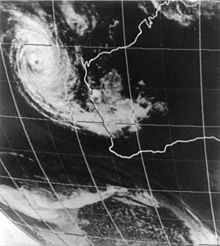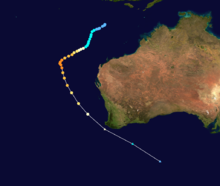- Cyclone Alby
-
Severe Tropical Cyclone Alby Category 5 cyclone (Australian scale) Category 4 Tropical Cyclone (SSHS) 
Satellite image of Cyclone Alby on 2 April 1978 Formed 27 March 1978 Dissipated 5 April 1978 Highest winds 10-minute sustained:
205 km/h (125 mph)
1-minute sustained:
215 km/h (135 mph)Lowest pressure 930 mbar (hPa; 27.46 inHg) Fatalities 5 direct, 2 indirect Damage $45 million (1968 USD) Areas affected Western Australia Part of the 1977–78 Australian region cyclone season Severe Tropical Cyclone Alby was regarded as the most devastating tropical cyclone to impact southwestern Western Australia on record. Forming out of an area of low pressure on 27 March, Alby steadily developed as it tracked southwestward, parallel to Western Australia. Between 1 and 2 April, the storm quickly intensified and attained its peak intensity as a Category 5 cyclone on the Australian cyclone intensity scale. After turning to the southeast, the storm underwent an extratropical transition as it neared Cape Leeuwin. The storm brushed the cape on 4 April, bringing hurricane-force winds, before rapidly losing its identity the following day.
In Western Australia, the combination of Alby's fast movement and hurricane-force winds caused widespread damage. Along the coast, large swells flooded low-lying areas and numerous homes lost their roofs from high winds. Further inland, bushfires were worsened by the storm as it brought little rain, generally less than 20 mm (0.79 in) along the coast. These fires burned roughly 114,000 hectares (281,700 acres) and destroyed two towns. Five fatalities are directly attributed to Alby while two more resulted from the fires. The resulting damage was extensive, with monetary losses reaching A$50 million ($45 million USD).
Contents
Meteorological history
Severe Tropical Cyclone Alby was first identified on 27 March 1978 as a disorganized area of low pressure situated roughly 800 km (500 mi) north-northwest of Karratha. At this time, the system was characterised as a large cluster of convection converging around the low. Notable development took place over the following three days as the system drifted towards the southwest. Convection began wrapping around the storm, forming banding features.[1] Early on March 29, the Joint Typhoon Warning Center (JTWC), classified the system as a tropical storm.[2] Shortly thereafter, the Bureau of Meteorology in Perth classified it as a tropical cyclone, assigning it with the name Alby.[3] Gale force winds were later confirmed on 30 March by the Martha Bakke, located 385 km (239 mi) west-northwest of the storm's centre. By then, a large ragged eye developed and Alby steadily intensified through 2 April.[1] At the end of this strengthening, Cyclone Alby attained its peak intensity as a Category 5 on the Australian cyclone intensity scale; a barometric pressure of 930 mbar (hPa; 27.46 inHg) was measured at the time and peak winds were estimated to be 205 km/h (125 mph) based on the Dvorak technique.[1][3] Additionally, the JTWC assessed the storm to have attained winds of 215 km/h (135 mph), a low-range Category 4 on the Saffir–Simpson Hurricane Scale.[4]
Shortly after reaching this intensity, Alby slowed as it began turning towards the southeast. By 3 April, the storm rapidly accelerated and attained a forward speed of 50 km/h (31 mph).[1] This rapid acceleration was due to the cyclone's interaction with a cold front to its south.[5] Gradually weakening, Alby also underwent an extratropical transition as the storm's structure became asymmetrical.[6] Around 1300 UTC, the storm passed within 100 km (65 mi) of Cape Leeuwin as an extratropical storm. Due to the rapid movement of Alby, the system maintained winds of 120 km/h (75 mph) as it reached this point, making it one of the most intense storms to strike the region. By 5 April, the cyclone rapidly lost its identity as it became caught up in a northwesterly flow before merging with the cold front over the Great Australian Bight.[1]
Impact and aftermath
Retaining winds in excess of 120 km/h (75 mph), Cyclone Alby brought damaging winds to much of the region in and around Cape Leeuwin.[1] The highest winds reached 150 km/h (90 mph) in Albany.[5] In Perth, a peak gust of 130 km/h (80 mph) was measured, the third-highest in the city's history.[6] The intense winds, considered unprecedented for many in the region, were attributed to the fast movement of the storm and its location in relation to land. Moving at speeds up to 90 km/h (56 mph), winds along the northeastern edge of the storm were increased by that amount due to Alby's clockwise rotation. It also allowed for winds to cover a large area northeast of the centre, impacting many areas far from the storm.[5] In general, rainfall was limited and generally less than 20 mm (0.79 in); this was due to the fast movement, as well as the asymmetrical structure with most of the thunderstorms south of the center.[1]
These winds resulted in widespread agricultural, environmental and structural damage. Hundreds of structures sustained severe damage, mostly consisting of roofs blowing off. The most severe losses took place in Albany where most homes had partial or complete roof failure. Air-borne debris also damaged buildings during the storm. Nearly 80% of the apple crop was lost in the Donnybrook-Manjimup area. A total of 154,400 m3 (5.4 million ft3) of timber was lost as well as a potential 200,000 m3 (7 million ft3) of future growth on established trees. Widespread dust storms also ruined crops and removed topsoil from many areas. Near the coast, the combined effects of strong, onshore winds and little rain led to significant inland sea spray. Numerous power lines and stations failed during the storm due to winds as well as dust and salt accretion. Large portions of the South-West Land Division were without electricity due to Cyclone Alby; Perth nearly sustained a complete breakdown of power services. This led to secondary losses attributable to the storm such as production failure.[1]
The large expanse of gale-force winds without precipitation exacerbated 92 ongoing brush fires in the region.[7] These fires erupted into full-fledged wildfires, expanding at a rate of 5 to 10 km/h (3.1 to 6.2 mph). A total of 114,000 hectares (281,700 acres) of land was burned throughout Western Australia as a result of the fires. Within this area, more than 10,000 sheep and 500 cattle and horses were killed. Over 100 structures, 1,300 km (810 mi) of fencing and tens of thousands of hay bales were destroyed.[6] According to newspaper reports, two towns were leveled by the wildfires.[8] At least 50 individual fires were fanned by the storm across the region, prompting more than 1,000 firefighters to assist in putting them out.[9] Two fatalities were attributed to these fires.[10]
Along the coast, large swells produced by the storm resulted in two fatalities in Albany Harbour as well as significant coastal damage. Tides across the region were expected to increase. Unexpectedly, all forecast values were exceeded by at least 0.3 m (0.98 ft).[1] The highest storm tide was in Busselton at 2.5 m (8.2 ft), leading to a storm surge of 1.1 m (3.6 ft).[6] Here, the surge penetrated roughly 200 m (660 ft) inland, forcing several evacuations. This led to significant coastal flooding that damaged dozens of structures. In Bunbury, water breached the sea wall, inundating 100 homes and prompting the evacuation of 130 residents.[1] Throughout Western Australia, Cyclone Alby was responsible for seven fatalities and A$50 million (A$213 million 2011;[nb 1] $284 million 2011 USD[nb 2]) in damage.[1] There was also severe beach erosion associated with the storm, with some areas losing 30 m (98 ft) of land.[14] Due to the extensive damage, the name Alby was retired from the list of Western Australian cyclone names following its usage.[15]
In the wake of Cyclone Alby, an appeal for relief in the affected region was made by The Lord Mayor's Distress Relief Fund.[16] The unprecedented scale of damage prompted meteorologists to vastly improve forecasting in the region to be better prepared for a similar storm in the future. At the time, little to no warning was given to residents in the South-West Land Division; this was the result of Alby's abrupt acceleration along a cold front, a complex forecasting situation. It was also regarded as a "wake up call" for the region, reminding residents that they are not immune to the effects of tropical cyclones.[5] Cyclone Alby has been used as a benchmark to compare future storms in the region to, such as Severe Tropical Cyclone Bianca in 2011.[17]
See also
- List of cyclones in Western Australia
- List of retired Australian cyclone names
References
- ^ a b c d e f g h i j k Perth Tropical Cyclone Warning Centre (2010). "Tropical Cyclone Alby Report" (PDF). Australian Bureau of Meteorology. http://www.bom.gov.au/cyclone/history/pdf/alby.pdf. Retrieved 29 January 2011.
- ^ Joint Typhoon Warning Center (1979). "Tropical Cyclone 29S Best Track" (TXT). United States Navy. http://www.usno.navy.mil/NOOC/nmfc-ph/RSS/jtwc/best_tracks/1978/1978s-bsh/bsh291978.txt. Retrieved 29 January 2011.
- ^ a b "Raw cyclone track data" (XLS). Australian Bureau of Meteorology. 2007. ftp://ftp.bom.gov.au/anon2/home/ncc/cyclone/Newcyclonedatabase.zip. Retrieved 29 January 2011.
- ^ Joint Typhoon Warning Center (1979). "Tropical Cyclone 30S Best Track" (TXT). United States Navy. http://www.usno.navy.mil/NOOC/nmfc-ph/RSS/jtwc/best_tracks/1978/1978s-bsh/bsh301978.txt. Retrieved 4 February 2011.
- ^ a b c d Staff Writer (3 April 2008). "Cyclone Alby impact resonates thirty years on". Australian Broadcasting Corporation. http://www.webcitation.org/5wFU5WTIk. Retrieved 4 February 2011.
- ^ a b c d "Tropical Cyclone Alby". Bureau of Meteorology. 2011. http://www.bom.gov.au/cyclone/history/wa/alby.shtml. Retrieved 4 February 2011.
- ^ Rick Sneeuwjagt (2008). "Prescribed Burning: How Effective is it in the Control of Large Forest Fires" (PDF). Department of Environment & Conservation. http://www.royalcommission.vic.gov.au/getdoc/e9e5a53e-5406-4f94-977f-7e7d05ffaf46/WIT.135.001.0099. Retrieved 4 March 2011.
- ^ Associated Press (5 April 1978). "Tropical cyclone kills 5". The Star-Phoenix: p. 44. http://news.google.com/newspapers?id=4pVjAAAAIBAJ&sjid=a3oNAAAAIBAJ&dq=perth%20storm&pg=3157%2C1371431. Retrieved 5 February 2011.
- ^ Staff Writer (6 April 1978). "Five dead in storm: fires rage on". The Sydney Morning Herald: p. 1. http://news.google.com/newspapers?id=cdYjAAAAIBAJ&sjid=e-YDAAAAIBAJ&dq=cyclone%20alby&pg=3906%2C1931518. Retrieved 5 February 2011.
- ^ "Event - South-Western, WA: Cyclone". Government of Australia. 2011. http://www.disasters.ema.gov.au/Browse%20Details/DisasterEventDetails.aspx?DisasterEventID=2726. Retrieved 4 February 2011.
- ^ "Inflation Calculator". Reserve Bank of Australia. 2010. http://www.rba.gov.au/calculator/annualDecimal.html. Retrieved 29 January 2011.
- ^ "US Dollar Per Australian Dollar". Data 360. 2011. http://www.data360.org/dsg.aspx?Data_Set_Group_Id=1306. Retrieved 29 January 2011.
- ^ "What is a dollar worth?2011". Federal Reserve Bank of Minneapolis. 2011. http://www.minneapolisfed.org/Research/data/us/calc/.
- ^ V. Semeniuk and D. J. Searle (Summer 1987). "Beach Rock Ridges/Bands along a High-Energy Coast in Southwestern Australia: Their Significance and Use in Coastal History". Journal of Coastal Research (Coastal Education & Research Foundation, Inc.) 3 (3): 331–342. ISSN 0749-0208. JSTOR 4297307.
- ^ "Tropical Cyclone Operational Plan for the South Pacific and South-East Indian Ocean" (PDF). World Meteorological Organization. 2006. http://www.wmo.int/pages/prog/www/tcp/documents/TCP-24-OP-PLN-2006-edition-english.pdf. Retrieved 5 February 2011.
- ^ "Previous Relief Appeals". The Lord Mayor's Distress Relief Fund. 2009. http://www.appealswa.org.au/previousappeals.html. Retrieved 4 February 2011.
- ^ Sharon Kennedy (26 January 2011). "The difference between cyclones Alby and Bianca". Australian Broadcasting Corporation. http://www.webcitation.org/5wH1vzUNP. Retrieved 5 February 2011.
- Notes
- ^ Australian dollar inflation rates obtained through the consumer price index.[11]
- ^ United States dollar values obtained through historic conversion rates and the consumer price index.[12][13]
List of retired Australian cyclone names 1960s 1970s 1980s 1990s 2000s 2010s Categories:- Retired Australian region cyclones
- Cyclones in Australia
- Category 5 Australian region cyclones
- 1978 in Australia
- 1978 natural disasters
Wikimedia Foundation. 2010.


